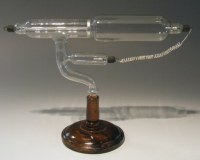








The mid- to late- 1800s was a period of scientific revolution with phtsical processes such as electricity beginnning to reveal their secrets.Early investigations in to electricity led to the development of the cathode ray tube,which would eventually lead to the discovery of the electron,as well as to the invention of television.
Michael Faraday(1791-1867) noticed that after removing most of the air in a glass tube containing a cathode and anode,a faint Glow could be seen between the positive and negative electrodes.Faraday's work was limited initially by the inability to create more than a partial vacuum.
Around 1855 German Scientists Heinrich Geissler and Julius Plucker improved vacuum technology and were able to remove more of the air from inside such a tube.With the improved vacuum,Plucker was able to produce a much brighter glow between the electrodes.He was also able to demonstrate that the glow responded to the effects of a magnetic field.
English chemist and physicist William Crookes(1832-1919) had already made significant discoveries before he turned his attention to vacuum tubes.Using his crookes tubes,which created an even better vacuum than those of Geissler and Plucker,he showed That the "cathode rays" that cause the glow traveled in straight lines,causing phosphorescence upon striking certain materials.Crookies also installed tiny vanes that would turn in the tubes as the current was applied .He thought he had discovered a fourth state of matter-"radiant matter"-but the true nature of this phenomenon had to wait until J.J.Thompson's studies showed these particles to be subatomic.